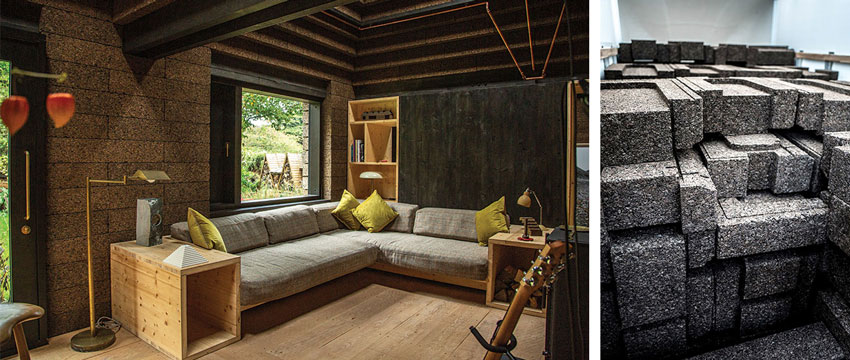Bio-Based Materials
The construction system consists of cork blocks made purely of heat-expanded and -bonded granules from the bark of the cork oak tree. The species, native to the Mediterranean region, and not to be confused with North America’s endangered white or stave oak, can have its bark removed without damaging the tree. It then regrows, so that a single tree can be harvested more than 15 times over its 200-year-plus lifespan. Ancillary structural elements, such as lintels and a ring beam to take lateral roof loads, are built in acetylated wood1 (softwood that’s been hardened in a process that essentially pickles it in a kind of vinegar). Cedar weatherboards clad sloped surfaces on the roof blocks to prevent water from seeping between the horizontal blocks’ granules.
The blocks were developed by the design team in collaboration with researchers at the Bartlett, University of Bath, and cork-product manufacturers Armorim UK and Ty-Mawr. Deriving from the architects’ longstanding dissatisfaction with the life-cycle complexity of contemporary building materials, the blocks provide all-in-one structure, weather envelope for vertical surfaces, insulation, and interior finish. They are site-assembled by hand, with a tongue-and-groove friction fit that requires neither fasteners nor glue, and are designed for disassembly and reuse at the end of the building’s life.
Having socked away more atmospheric carbon than its construction entailed, the house was carbon negative at its completion in 2019. Its whole-life emissions are estimated at an extraordinarily low 618 kilograms of carbon dioxide equivalent per square meter (kgCO2e/m2). That figure includes 286 kgCO2e/m2 in embodied carbon (because the standard used for the assessment doesn’t account for carbon sequestration) and 332 kgCO2e/m2 in operational carbon, based on the standard’s assumption of a 60-year lifespan. The emissions, which include end-of-life, are the lowest the project’s third-party assessor has evaluated to date. “Embodied carbon was a particular focus for this project,” says Howland. “Because this reduction in CO2 is delivered at the start of the building’s life, it helps contribute to urgently needed carbon reductions now.”

PHOTOGRAPHY: © MAGNUS DENNIS (LEFT); COURTESY CSK ARCHITECTS (RIGHT)
THE STRUCTURE, weather envelope, insulation, and interior finish (left) of the Cork House consist almost entirely of cork blocks (right) that are tongue-and-groove friction-fit together.
A factor limiting the widespread adoption of cork at this point is its structural capacity. It’s a bit squidgy, so the load-bearing blocks will compress over the first year or so of the building’s life. The next building in this ongoing investigation will incorporate slightly more wood, expanding the utility and market potential of cork to include multistory construction. But for Howland, the project’s thesis isn’t simply cork. It’s the architectural response to life-cycle considerations behind material resources, fabrication, disassembly, and “how those considerations manifest themselves in the actual architectural thing.”
Another building making that question central is Ashen Cabin, designed by Leslie Lok and Sasa Zivkovic, researchers at Cornell University’s Department of Architecture and co-principals at Ithaca-based HANNAH Architecture and Design. But instead of cork, this building, completed last year in upstate New York, expresses the properties of an innovative material developed in response to the catastrophe now overtaking North America’s ash trees.
Casualties of global connectivity, most of the continent’s 8.7 billion ash trees are expected to succumb in the next 50 years to the invasive emerald ash borer. Tens of millions of trees have already been killed, and, unlike the beetle-killed pine forests that went before, the irregular geometries typical of ash defy regular sawmills. To prevent all that wood’s going to waste—and, in the process, releasing its sequestered carbon to an overloaded atmosphere—Lok and Zivkovic have developed a process that applies contemporary technologies to transform the irregular logs into an affordable and distinctive building material. “Looking at this ash tree as a resource reminds us that, as designers, we’re often limited by the standard materials offered by the building industry,” says Lok. “This biomaterial is an opportunity for us to find how to use an enormous alternative resource in a meaningful way.”
The process she and Zivkovic have developed deploys 3-D laser scanning and robotics-based fabrication techniques (basically, a programmable band saw) to cut irregular logs into naturally curving boards of desired thicknesses. The boards are then assembled with a biodegradable closed-cell foam to form structural insulated panels (SIPs).
Ashen Cabin, the 100-square-foot prototype, consists of an ash SIP superstructure on a 3-D-printed concrete foundation. (3-D printing allows the design to minimize the amount of high-embodied-energy concrete.) The cabin comprises three programmatic areas: a table, a storage-seat element, and a 21-foot-tall fireplace. As a building rather than an installation, the project is intended to demonstrate the material’s ability to provide a ventilated, waterproof, and structural envelope.









